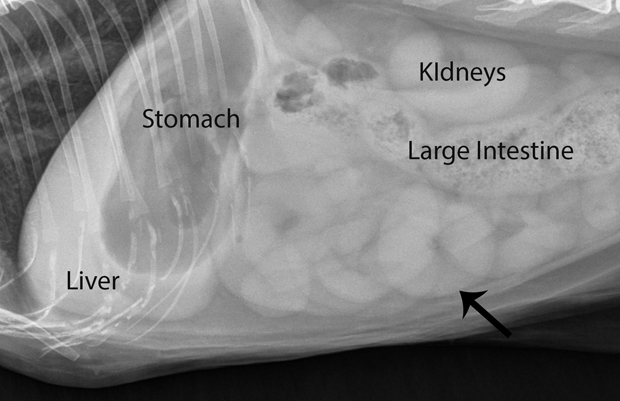
Photo by Ingamiv.
Our veterinary is commonly presented with a dog or a cat with a greatly distended abdomen. This condition can be caused by weakened abdominal muscles from Cushing’s disease. A gastric bloat, in which excess air builds up in the stomach, can also cause a distended abdomen.
More commonly, though, a distended abdomen is a result of excess abdominal fluid. The buildup of abdominal excess fluid, called ascites, has many different causes and could be a sign of an important problem.
Depending on the cause, there are many symptoms an owner might notice if their pet has ascites:
- difficulty breathing
- difficulty walking
- lethargy
- poor appetite
- coughing
- vomiting
- weight gain
- discomfort
Some of the causes to ascites include:
- low protein level in the bloodstream because of inadequate diet, inability to absorb protein in the intestines, or excess loss of protein through the intestines, or kidneys failure of the right side of the heart
- cancer
- internal bleeding
- internal parasites
- peritonitis
- urinary bladder
- rupture liver disease
- FIP in cats
Ascites is commonly diagnosed with a radiograph. There will be an inability to view the abdominal organs because of the fluid buildup. Young animals and those severely underweight can show a radiographic appearance similar to ascites when in fact that inability to view the abdominal organs comes from a lack of normal abdominal fat.

This is a normal radiograph of the abdomen, for reference purposes. The arrow points to the small intestines. Photos courtesy of Long Beach Animal Hospital (LBAH) unless otherwise indicated.
In some cases, an abdominal ultrasound is needed to diagnose whether ascites is present. It helps significantly as to the cause of the ascites as well as allows the veterinarian to determine the presence of ascites.
Another common test for ascites is an abdominal tap, called abdominocentesis. In this test, abdominal fluid is removed and analyzed microscopically for abnormal cells like cancer cells. This fluid can also be cultured for infection. After fluid samples have been obtained for diagnostic testing, we remove as much abdominal fluid as possible, which dramatically decreases discomfort.
Treatment for Ascites
Treatment varies and depends on the cause. It can be very effective and affect a cure, but it might not be helpful if cancer or advanced heart failure is present. Treatment could include medication or mechanical removal of the fluid during abdominocentesis.

We remove the fluid by abdominocentesis for diagnostic and treatment purposes. This excess fluid is painful, and removal greatly reduces this pain.
For more information on the diseases of pets in our area, please visit the Diseases section of our website.

